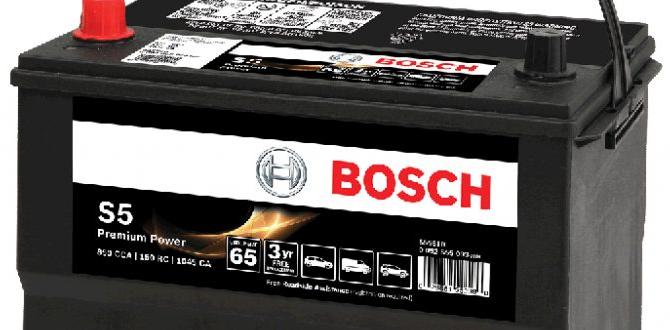Quick Summary: Looking for a cheap lead acid car battery for trucks? You can find affordable options that offer reliable power. This guide breaks down what to consider, how to choose wisely, and essential maintenance to keep your truck starting strong, even on a budget.
Cheap Lead Acid Car Battery for Trucks: Your Essential Guide
Is your truck battery giving you trouble? Maybe it’s struggling to start on cold mornings, or perhaps you’ve had to jump-start it more than once. A weak battery is a common headache for truck owners, and replacing one can seem like a big expense. But what if you could find a dependable battery that’s also easy on your wallet? This guide is here to help. We’ll walk you through everything you need to know about choosing and caring for a cheap lead acid car battery for your truck, making sure you get the best value without sacrificing performance.
We’ll cover what makes a lead acid battery suitable for trucks, how to spot a good deal, crucial safety tips, and simple maintenance tricks. No confusing jargon, just clear, practical advice from someone who understands power and reliability. Let’s get your truck back to being a dependable workhorse!
Understanding Lead Acid Batteries for Trucks
When we talk about car batteries, especially for trucks, we’re usually talking about lead acid batteries. They’ve been the standard for a long time, and for good reason. They work by creating a chemical reaction between lead plates and a sulfuric acid solution. This reaction produces the electrical power your truck needs to start its engine and run its accessories.
Why are they so common for trucks? They’re tough. Trucks, particularly work trucks or those used for towing, often demand more power than smaller cars. Lead acid batteries are built to deliver that high starting current (also known as Cold Cranking Amps or CCA), which is super important for firing up a big engine, especially in colder weather. They are also generally more affordable compared to other battery technologies. While there are newer types of batteries out there, lead acid remains a reliable and cost-effective choice for most truck applications.
Key Components of a Lead Acid Battery
A lead acid battery might look simple from the outside, but it has several important parts working together:
- Plates: These are made of lead and lead dioxide. They are the core of the battery’s power generation.
- Electrolyte: This is a mixture of sulfuric acid and distilled water. It allows the chemical reaction to happen.
- Separator: Thin sheets made of porous plastic or fiberglass. They keep the positive and negative plates from touching, which would cause a short circuit.
- Case: The tough outer shell that holds everything together and protects the internal components. It’s usually made of durable plastic.
- Terminals: The positive (+) and negative (-) posts where you connect your truck’s battery cables.
These components work in harmony to store electrical energy and release it when your truck needs it. For a truck, especially if you’re looking for a budget-friendly option, a well-made lead acid battery is usually the way to go.
What Makes a Battery “Cheap” and What to Look Out For
When you search for a “cheap lead acid car battery for trucks,” you’re looking for a balance. You don’t want the absolute cheapest battery if it means it will die in a year. You want a battery that offers good value for its price.
Here’s what often makes a battery cheaper, and what you should be mindful of:
- Brand Recognition: Well-known brands might cost a bit more due to their reputation and established distribution, but they often come with better warranties and more consistent quality control. Smaller or store-brand batteries can be significantly cheaper. They might be just as good, but you’re not paying for the brand name.
- Warranty Length and Terms: A shorter warranty (e.g., 12 months) typically means a lower price. A longer warranty (e.g., 36 months or more) indicates the manufacturer’s confidence in the battery’s longevity, but it will usually cost more upfront. For a budget battery, look for a decent warranty that covers basic defects.
- Performance Ratings: Batteries built for extreme temperatures or heavy-duty applications (like frequent towing or hauling) often have higher CCA ratings and reserve capacity, making them more expensive. For standard truck use, you can often find perfectly adequate batteries at a lower price point by choosing one with sufficient, but not excessive, ratings.
- Construction and Features: Some batteries have extra features like low-maintenance designs (where you don’t need to top up water) or advanced vibration resistance, which add to the cost. Simpler, traditional flooded lead acid batteries are usually the most budget-friendly.
So, a “cheap” battery isn’t necessarily a bad battery. It just means it likely has a more basic design, a shorter warranty, or comes from a less established brand. The key is to ensure it still meets your truck’s essential power needs.
Essential Battery Specifications for Trucks
Before you buy any battery, even a cheap one, you need to know what your truck requires. The three most important specs are:
- Group Size: This is a standard sizing system that tells you the physical dimensions, terminal configuration, and layout of your battery. Your truck’s owner’s manual will tell you the correct group size. Using the wrong size can lead to fitment issues or improper connections.
- Cold Cranking Amps (CCA): This is the most critical rating for starting your engine, especially in cold weather. It measures how much power the battery can deliver for 30 seconds at 0°F (-18°C) without dropping below 7.2 volts. Your truck manufacturer will recommend a minimum CCA rating. It’s usually a good idea to get a battery that meets or slightly exceeds this.
- Reserve Capacity (RC): This tells you how long the battery can supply 25 amps at 80°F (27°C) before its voltage drops too low. A higher RC means the battery can power your truck’s accessories (lights, radio, etc.) for a longer time if the alternator isn’t working, or if the engine is off. Trucks that use a lot of accessories or do a lot of idling might benefit from a higher RC.
You can usually find these specifications on a sticker on your current battery, in your truck’s owner’s manual, or by looking up your truck’s make and model online on auto parts websites. Always double-check!
Where to Find Cheap Lead Acid Car Batteries for Trucks
You don’t have to go to the dealership for a battery. Many places offer affordable options. Here are some common places to look:
- Auto Parts Stores: Major chains like AutoZone, Advance Auto Parts, O’Reilly Auto Parts, and Pep Boys usually carry a range of batteries. They often have store brands that are more affordable than premium brands and frequently run sales.
- Mass Retailers: Stores like Walmart, Costco, and Sam’s Club often have their own battery brands (e.g., EverStart at Walmart) that are priced competitively. They’re a great option for a no-frills, reliable battery.
- Online Retailers: Websites like Amazon, eBay, and dedicated battery online stores can offer great deals. Be sure to check shipping costs and return policies carefully, as batteries can be heavy. Make sure to confirm compatibility with your truck before purchasing.
- Local Independent Shops: Sometimes, smaller, independent mechanics or battery specialists can offer competitive prices, especially on less common brands or if you ask about budget options.
- Salvage Yards/Used Options (with caution): While not generally recommended for critical components like batteries, some individuals sell used batteries. This is very risky as you don’t know the battery’s history or remaining life. For a truck, it’s best to buy new to ensure reliability.
When comparing prices, always factor in the warranty. A slightly more expensive battery with a longer warranty can save you money in the long run if you need to replace it sooner than expected.
Comparing Prices and Warranties
Let’s look at a hypothetical example of how you might compare options:
| Brand/Retailer | Price (Approx.) | Warranty (Free Replacement) | Warranty (Pro-Rated) | Notes |
|---|---|---|---|---|
| Premium Brand (e.g., DieHard Gold) | $180 – $250 | 24-36 months | 60-100 months | High CCA, long life, robust |
| Store Brand (e.g., EverStart Maxx) | $120 – $160 | 18-24 months | 60-84 months | Good value, meets OEM specs |
| Budget Option (e.g., Basic Interstate/Tractor Supply) | $90 – $130 | 12-18 months | 36-60 months | Lowest upfront cost, basic needs |
For a “cheap lead acid car battery for trucks,” you’d likely be looking at the “Store Brand” or “Budget Option” categories. When evaluating, consider how long you plan to keep the truck. If it’s just a couple of years, a shorter free replacement warranty might be acceptable. If you plan to keep it longer, paying a little more for a better warranty could be wise.
How to Replace Your Truck Battery Safely
Replacing a car battery might seem intimidating, but it’s a manageable DIY task if you follow safety precautions. Remember, batteries contain acid and can produce explosive gases, so safety first!
Tools and Materials You’ll Need
- New Battery (correct group size, CCA, and terminal configuration)
- Wrench Set or Socket Set (commonly 10mm or 13mm for terminals, and often a larger size for the battery hold-down)
- Battery Terminal Cleaner Tool (wire brush attached to a cleaner) or a stiff wire brush and baking soda/water paste
- Gloves (acid resistant, like rubber or nitrile)
- Safety Glasses
- Rags or Paper Towels
- Optional: Anti-corrosion spray or grease
- Optional: Small piece of sandpaper
Step-by-Step Battery Replacement Guide
Always ensure your truck is turned off and the parking brake is engaged. If you have a modern vehicle with complex electronics, consult your owner’s manual or consider using a battery saver device to maintain power to the car’s computer during the swap.
- Locate the Battery: Pop the hood and find the battery. It’s usually in the front of the engine bay, but can sometimes be in the trunk or under a seat in some vehicles.
- Disconnect the Negative Terminal First: Using the appropriate wrench, loosen the nut on the negative (-) terminal clamp. Twist and pull the cable straight up off the terminal. Tuck it away so it can’t accidentally touch the battery post. Why negative first? This prevents accidental short circuits. If you touch a metal tool to the engine block (ground) while working on the positive terminal, it won’t create a spark. Most sources, like the U.S. Department of Energy’s Vehicle Technologies Office, emphasize safe practices.
- Disconnect the Positive Terminal: Now, loosen the nut on the positive (+) terminal clamp. Twist and pull the cable straight up off the terminal.
- Remove the Battery Hold-Down: There’s usually a bracket or clamp securing the battery in place. Identify the bolts or nuts holding it down and remove them using your wrench or socket set. Keep these parts safe; they’re important!
- Remove the Old Battery: With the hold-down removed and terminals disconnected, carefully lift the battery straight up and out of the tray. Batteries are heavy, so use your legs and be careful not to strain yourself.
- Clean the Battery Tray and Terminals: Inspect the battery tray for corrosion or damage. If it looks OK, thoroughly clean the battery cables’ clamps. Use a battery terminal cleaner tool or a wire brush with a baking soda and water paste. Rinse with a bit of water (carefully!) and then dry completely. Clean posts on the new battery if needed. A clean connection is vital for good power flow.
- Install the New Battery: Carefully lower the new battery into the tray, ensuring it’s oriented correctly (positive and negative terminals in the right positions to match your cables).
- Secure the Battery Hold-Down: Reinstall the hold-down bracket and tighten it securely. The battery should not be able to move around.
- Connect the Positive Terminal First: Place the positive (+) cable clamp onto the positive terminal post. Tighten the nut securely.
- Connect the Negative Terminal Last: Place the negative (-) cable clamp onto the negative terminal post. Tighten the nut securely.
- Final Check and Startup: Double-check that both terminals are tight and the battery is secure. You can apply a thin layer of anti-corrosion spray or grease to the terminals to prevent future corrosion. Now, start your truck! It should fire up smoothly.
If your truck has a plastic tray, make sure it’s clean and free of debris. If your old battery leaked, you might need to clean the tray more thoroughly with a baking soda solution and water. For more advanced DIYers, some resources, like AutoZone’s repair guides, offer detailed visual instructions for various vehicles.
Battery Maintenance for Longevity and Reliability
Even a cheap battery can last longer if you take good care of it. Regular, simple maintenance can make a big difference and save you from prematurely needing another replacement.
Essential Maintenance Tips
- Keep Terminals Clean: As mentioned in the replacement steps, corrosion is the enemy of good electrical contact. Regularly check your battery posts and cable clamps for white or bluish fuzzy buildup. Clean them at least twice a year or whenever you notice corrosion. A clean connection ensures your truck gets all the power it needs.
- Ensure Proper Tightness: Loose battery terminals are a common cause of starting problems and electrical gremlins. Give them a wiggle test occasionally. If they move, tighten them.
- Check Electrolyte Levels (for non-sealed batteries): If you have a traditional flooded lead acid battery with removable caps, check the fluid levels about once a month, especially in hot weather. The electrolyte (acid solution) should cover the lead plates. If it’s low, carefully add distilled water (never tap water or acid!) until the plates are just covered. Do NOT overfill. Many modern batteries are sealed and maintenance-free, so check if yours requires this.
- Protect from Extreme Temperatures: Extreme heat can shorten a battery’s life, while extreme cold reduces its power output. While you can’t control the weather, try to avoid parking in direct sun for extended periods on hot days if possible. Ensure your battery is properly secured to minimize vibration, which can also be exacerbated by temperature changes.
- Avoid Deep Discharges: Leaving lights on, or having accessories drain the battery when the engine is off too often can damage a lead acid battery. If you do accidentally discharge it, recharge it fully as soon as possible.
- Regular Charging: If your truck sits unused for long periods (weeks or months), the battery will naturally lose charge. A battery tender or smart charger can keep it topped up, preventing sulfation (crystallization on the lead plates) which reduces performance and lifespan.
Simple checks and cleaning can extend the life of your battery, whether it’s a budget option or a premium one. Think of it like changing the oil in your truck – consistent care pays off.
Understanding Battery Charging
If your battery is weak or has been drained, you might need to charge it. The easiest way for most people is using a battery charger.
- Charger Types:
- Manual Chargers: You set the amperage and monitoring time. Require more user attention.
- Automatic/Smart Chargers: These monitor the battery’s state and adjust charging rate, often shutting off when the battery is full. They are safer and easier to use, especially for beginners.
- Charging Process:
- Connect the charger clamps to the correct battery terminals (red to positive, black to negative).
- Plug in the charger and select the appropriate charge setting for your battery type and size. For a standard truck battery, a 10-amp setting is usually good for a decent recharge. A trickle charger (1-2 amps) is good for maintaining a charge over long periods.





